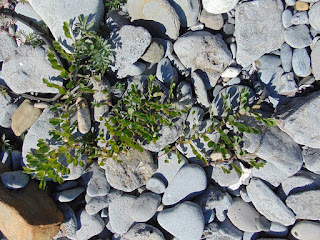2019 was another amazing year for recording in Wexford.
Almost 60,000 records were collected during the year. We set out a few aims at
the start of the year. One was to make sure all 2564 moands received a visit,
this I’m glad to say we achieved. Another was to try and find 100 or more
species per monad. At the end of 2018 there were 158 monads, by the end of this
year there are just 78 monads with 99 or less species. None of these are ever
likely to top the 100 mark, as most are around the border of the county, and
are part monads or high up in the Blackstairs Mountains.
The average number of species per monad has also increased
by 9 to 167.
The number of species for hectads has continued to increase.
T02 which includes Wexford Town still has the largest list of species, reaching
953 this year. The average number of species for the 42 hectads is 658.
Refinds for the county
There have been some exceptional refinds of native species
that were thought extinct in the county. Matthiola sinuata (Sea Stock) had been extinct
in Ireland since 1925 was refound on the east coast. On the south coast Cytisus
scoparius subsp. maritimus (Prostrate Broom) was refound on Baginbun Head in
large numbers, this broom that hugs the ground rather than growing upright was
last recorded here in the 1880s by H.C. Hart, and the first county record since
the 1960s. Also on the south coast Lathyrus japonicus (Sea Pea) was found on a
shingle beach on the Hook, 2nd county record, and first since 1994.
It wasn’t just native species that we had luck with, even as late as December Angelica
archangelica (Garden Angelica) was refound on the bank of the River Barrow at
New Ross, this garden escape last reported here in 1994 by Ro FitzGerald.
Sea Pea above
Broom above
Sea Stock above
New species & hybrids for the county
 31 new species and hybrids have been added to the county
list in 2019. 6 of these were hybrids. Only 8 out of the 31 were native: Geum x
intermedium (Water x Wood Avens) and 7 dandelions. Even though found in 2018,
but not named until 2019 was Euphrasia stricta, was the best record as this is
a new eyebright for Ireland.
31 new species and hybrids have been added to the county
list in 2019. 6 of these were hybrids. Only 8 out of the 31 were native: Geum x
intermedium (Water x Wood Avens) and 7 dandelions. Even though found in 2018,
but not named until 2019 was Euphrasia stricta, was the best record as this is
a new eyebright for Ireland.
Fun projects
Other fun projects included over the winter months trying to
find Stellaria media (Common Chickweed) for as many of the monads as possible.
Once you got the hang of what habitat Common Chickweed liked it was reasonably
easy to find, well used field gateways, fields resown to grass, and waste
ground were the best places to look. Surprisingly hard to find in stubble
fields and on road verges.
















